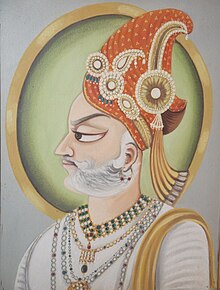Rawal Jaisal
| Rawal Jaisal | |
|---|---|
 Portrait of Rawal Jaisal inside Jaisalmer Fort | |
| Predecessor | Rawal Bhojraj (1147-1152) |
| Successor | Rawal Shalivahan II (1168-1190) |
| Born | Jaisal Singh Bhati 1113 |
| Died | 1168 |
| Spouse |
|
| Issue |
|
| House | Bhati |
| Father | Rawal Dusaj (1098-1122) |
| Religion | Hinduism |
Rawal Jaisal (r. c. 1153–1168), was a Rajput chief of Bhati clan who lived during the 12th century and founded the city of Jaisalmer and Jaisalmer state.[1]
Sixth in descent from Rawal Devraj of Derawar/Derawad (Derawar Fort is named after him) he was the eldest son of Rawal Dusaj, who had his capital at Laudrava.[2] When his father appointed Jaisal's younger half-brother Vijayraj Lanjha as his successor, Vijayraj, upon ascending the throne, drove Jaisal out of the kingdom. All this while he kept aloof from his brother's rule and when the latter died his infant son was made the ruler with Jaisal being appointed as his nephew's regent, Jaisal soon after ousted his nephew Rawal Bhojraj and succeeded to the throne of Bhatis. Four years into his reign, he laid the foundation of new capital city "Jaisalmer" in the year 1156 AD as the previous capital Laudrava was ruined in war.
His descendants intermingled in the geographies of Punjab, Haryana and Pakistan became the ancestors of Maharajas of Kapurthala State, Nabha State, Patiala State, Jind State and Faridkot State.[3][4]
Founding of Jaisalmer[edit]
While surveying Trikuta hill, a massive triangular rock rising more than 75 metres out of the surrounding sands, as a more secure location for a new capital, Rawal Jaisal met a sage called Eesul, who was staying on the rock. Upon learning that Jaisal was of Yaduvanshi descent, Eesul told him that according to ancient mythology Krishna and Bhima had come to this location for a ceremony, where Krishna had prophesied that a descendant of his Yaduvanshi clan would one day establish a kingdom here. Eesul showed him a spring which Krishna had created and his prophecy carved into a rock.[5] This rock still remains in a well in the Jaisalmer fort. Encouraged by this meeting Jaisal moved his capital to this location and established it in 1156[5] in the form of a mud fort and named it Jaisalmer after himself.
See also[edit]
References[edit]
- ^ Balfour, Edward (1885). The Cyclopædia of India and of Eastern and Southern Asia: Commercial, Industrial and Scientific, Products of the Mineral, Vegetable, and Animal Kingdoms, Useful Arts and Manufactures. B. Quaritch.
- ^ Balfour, Edward (1885). The Cyclopædia of India and of Eastern and Southern Asia. Original from Oxford University: B. Quaritch. p. 406.
- ^ "History of Sidhu & Brar Clan". Robbie Brar's blog. Retrieved 14 August 2023.
- ^ "Punjabi by nature: Punjab's Game of Thrones". HindustanTimes. 24 July 2016. Retrieved 24 July 2016.
- ^ a b Crump & Toh 1996, p. 208
Sources[edit]
- Crump, Vivien; Toh, Irene (1996). Rajasthan (hardback). London: Everyman Guides. p. 400 pages. ISBN 1-85715-887-3.
Further reading[edit]
- Martinelli, Antonio; Michell, George (2005). The Palaces of Rajasthan. London: Frances Lincoln. p. 271 pages. ISBN 978-0-7112-2505-3.
- Beny, Roland; Matheson, Sylvia A. (1984). Rajasthan - Land of Kings. London: Frederick Muller. p. 200 pages. ISBN 0-584-95061-6.
